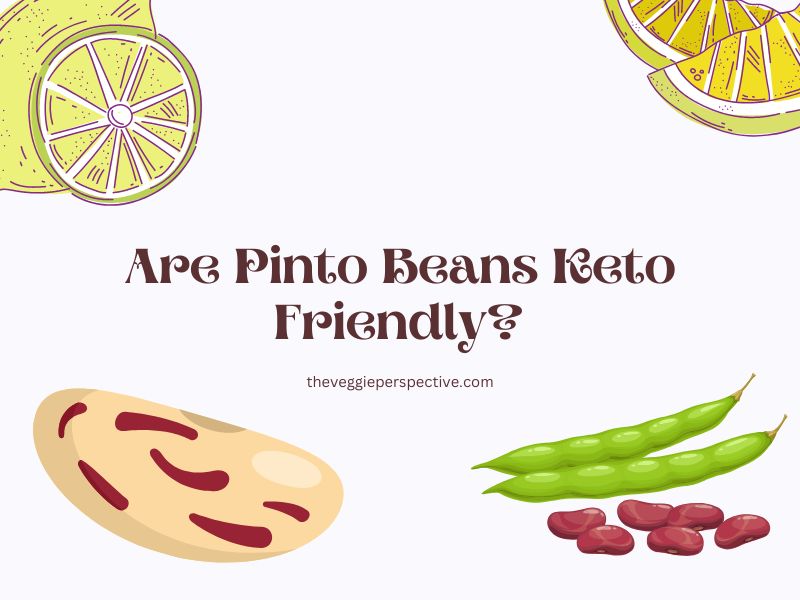I’ve been getting a lot of questions lately about whether pinto beans fit into a ketogenic diet. It’s a valid concern, as the keto diet is known for its low-carb approach. In this article, I’ll explore whether pinto beans are indeed keto-friendly and how you can incorporate them into your ketogenic lifestyle.
- Understanding the Keto Diet
- Pinto Beans and the Keto Diet
- Nutritional Profile of Pinto Beans
- Carbohydrates and Ketosis
- Incorporating Pinto Beans into a Keto Lifestyle
- Alternative Low-Carb Legumes
- Cooking and Enjoying Pinto Beans on Keto
- The Health Benefits of Pinto Beans
- Combining Pinto Beans into Your Keto Meal Plan
Understanding the Keto Diet
Before we delve into the specifics of pinto beans, let’s quickly recap the fundamentals of the ketogenic diet. The keto diet is a high-fat, low-carb diet that aims to put your body into a state of ketosis. Ketosis occurs when your body switches from using carbohydrates as its primary fuel source to using fat. To achieve this, the diet restricts carbohydrate intake, typically to around 20-50 grams per day.
The Nutritional Profile of Pinto Beans
When determining whether a food is keto-friendly, it’s essential to examine its nutritional composition. Here’s a breakdown of the nutritional values per 100 grams (3.5 ounces) of cooked pinto beans:
| Nutrient | Amount |
|---|---|
| Calories | 143 |
| Fat | 0.9 g |
| Carbohydrates | 26 g |
| Fiber | 9 g |
| Protein | 9 g |
As you can see, pinto beans contain a moderate amount of carbohydrates. However, they also offer a substantial amount of fiber, which is crucial when evaluating their impact on ketosis. Fiber is not fully digested by the body and does not contribute to net carbohydrate intake, making it an essential factor to consider.
Pinto Beans and the Keto Diet
While pinto beans do contain carbohydrates, their high fiber content can help offset their impact on blood sugar levels and ketosis. The fiber slows down the absorption of sugars (like in sweet potato), resulting in a more gradual rise in blood glucose levels. Consequently, pinto beans have a lower glycemic load compared to other carb-rich foods.
In moderate portions, pinto beans can be a part of a well-planned “ketogenic” diet. However, it’s crucial to track your carbohydrate intake and ensure that the beans fit within your daily limit. Keep in mind that individual carbohydrate tolerance may vary, and it’s best to consult with a healthcare professional or registered dietitian for personalized advice.
Nutritional Profile of Pinto Beans
Before diving into the ketogenic aspect, let’s take a closer look at the nutritional composition of pinto beans:
- One cup (171 grams) of cooked pinto beans contains:
- Calories: 245
- Fat: 1 gram
- Protein: 15 grams
- Total Carbohydrates: 45 grams
- Fiber: 15 grams
- Net Carbohydrates: 30 grams
Pinto beans are an excellent source of fiber, plant-based protein, and various vitamins and minerals. They are also low in fat, making them a healthy addition to any balanced diet. However, their carbohydrate content needs to be considered when following a ketogenic lifestyle.
Carbohydrates and Ketosis
The ketogenic diet is a high-fat, moderate-protein, and low-carbohydrate eating plan that aims to shift the body into a state of ketosis. In this metabolic state, the body primarily burns fat for energy instead of carbohydrates. To achieve and maintain ketosis, it’s important to limit your carbohydrate intake to a certain threshold.
While pinto beans offer valuable nutrients, their carbohydrate content is relatively high. Consuming a cup of cooked pinto beans provides around 30 grams of net carbohydrates. This amount can significantly impact your daily carbohydrate allowance, especially if you’re aiming to stay within the typical range of 20-50 grams per day on a ketogenic diet.
Incorporating Pinto Beans into a Keto Lifestyle
If you’re still interested in including pinto beans in your ketogenic diet, here are a few tips to consider:
- Portion Control: Limit the portion size of pinto beans to ensure you don’t exceed your daily carbohydrate limit.
- Count Net Carbs: Deduct fiber from the total carbohydrate count to calculate the net carbs, which have a significant impact on ketosis.
- Balance Macros: Adjust the fat and protein content of your meals to compensate for the carbohydrates from pinto beans, ensuring you maintain the desired macronutrient ratios.
- Timing: Consider consuming pinto beans in conjunction with other low-carb foods to help distribute your carbohydrate intake throughout the day.
- Individual Tolerance: Monitor your body’s response to pinto beans and determine if they hinder your progress towards ketosis or affect your overall well-being.
Remember, the ketogenic diet is highly individualized, and what works for one person may not work for another. It’s essential to listen to your body and make adjustments accordingly.
Rad also: Do Vegans Eat Seafood? Exploring Veganism and Seafood
Alternative Low-Carb Legumes
If you find that pinto beans don’t align well with your ketogenic goals, there are alternative legumes that are lower in carbohydrates and may be more suitable for your dietary needs. Consider incorporating the following legumes into your keto-friendly recipes:
- Green beans
- Snow peas
- Edamame
- Black soybeans
- Lentils (in moderation)
Cooking and Enjoying Pinto Beans on Keto
Now that we’ve established that pinto beans can be included in a keto diet, let’s explore some tips on how to prepare and enjoy them while staying within your macros.
- Portion Control: Keep an eye on your serving size to ensure you stay within your daily carbohydrate limit. A typical serving of cooked pinto beans is around ½ cup, which contains approximately 13 grams of carbohydrates. Adjust the portion according to your specific dietary needs.
- Pairing with Healthy Fats: Since the keto diet emphasizes high-fat intake, consider incorporating healthy fats when consuming pinto beans. You can add a dollop of guacamole, drizzle some olive oil, or sprinkle shredded cheese on top of your beans to boost the fat content and enhance the flavor.
- Combining with Low-Carb Ingredients: Create delicious keto-friendly meals by combining pinto beans with low-carb ingredients. Consider adding grilled chicken, avocado, spinach, or bell peppers to make a satisfying and well-rounded meal that aligns with your dietary goals.
- Meal Planning and Tracking: Planning your meals in advance and tracking your macronutrients is essential when following a keto diet. Use a food diary or a mobile app to keep track of your carbohydrate intake, ensuring that you stay within your daily limits while enjoying pinto beans and other keto-friendly foods.
- Exploring Other Low-Carb Bean Options: If you find that pinto beans don’t align with your specific dietary needs or preferences, there are other low-carb bean options you can explore. Examples include black soybeans, mung beans, or adzuki beans, which have lower carbohydrate content compared to pinto beans.
Pinto beans can be a nutritious addition to your meals when consumed mindfully and in appropriate portions.
The Health Benefits of Pinto Beans
Aside from their compatibility with the ketogenic diet, pinto beans offer several health benefits that make them a worthwhile addition to any balanced eating plan. Here are some reasons why incorporating pinto beans into your meals can be beneficial:
- Excellent Source of Fiber: Pinto beans are rich in dietary fiber, with approximately 9 grams of fiber per 100 grams. Fiber plays a crucial role in maintaining digestive health, promoting regular bowel movements, and supporting overall gut health. It can also help with weight management by providing a feeling of fullness and reducing the risk of overeating.
- Plant-Based Protein: Pinto beans are a good source of plant-based protein, providing approximately 9 grams per 100 grams. Protein is essential for tissue repair, muscle maintenance, and the production of enzymes and hormones. Incorporating plant-based proteins like pinto beans into your diet can contribute to a well-rounded nutrient intake.
- Rich in Micronutrients: Pinto beans contain a range of micronutrients that are vital for overall health. They are a good source of folate, magnesium, potassium, iron, and zinc. Folate is crucial for cell division and DNA synthesis, while magnesium, potassium, and zinc are involved in various physiological processes, including muscle function, bone health, and immune support.
- Promote Heart Health: The fiber content in pinto beans, coupled with their low saturated fat and cholesterol levels, can contribute to heart health. High-fiber diets have been linked to a reduced risk of heart disease and can help manage cholesterol levels by lowering LDL (bad) cholesterol.
Combining Pinto Beans into Your Keto Meal Plan
Now that you know pinto beans can be part of your keto diet, let’s explore some creative ways to incorporate them into your meals:
- Salads and Wraps: Add cooked and cooled pinto beans to your salads or use them as a filling for low-carb wraps. Combine them with fresh vegetables, a protein source, and a flavorful dressing for a satisfying and nutritious meal.
- Soups and Stews: Pinto beans can enhance the texture and flavor of soups and stews. Consider adding them to a hearty vegetable soup or a chili made with keto-friendly ingredients like ground beef, tomatoes, and spices.
- Bean-Based Dips: Puree cooked pinto beans with garlic, lemon juice, and spices to create a delicious and creamy bean dip. Pair it with keto-friendly vegetable sticks or low-carb crackers for a flavorful snack or appetizer.
- Side Dish Accompaniment: Serve cooked pinto beans as a side dish alongside grilled meats or roasted vegetables. Season them with herbs, spices, and a drizzle of olive oil to elevate their taste.
Remember to adjust the portion size of pinto beans based on your individual carbohydrate goals and dietary needs. Be mindful of the other ingredients you combine with pinto beans to ensure they align with your keto lifestyle.
Check our article: What to Eat with Broccoli Cheddar Soup? Delicious Ideas
I have always loved cooking and discovering new flavors. My hobby gradually grew into a serious hobby and now I write about food professionally on my blog. For almost a year now, I’ve been sharing my thoughts with the world and helping many people find their perfect “recipe” 🙂

